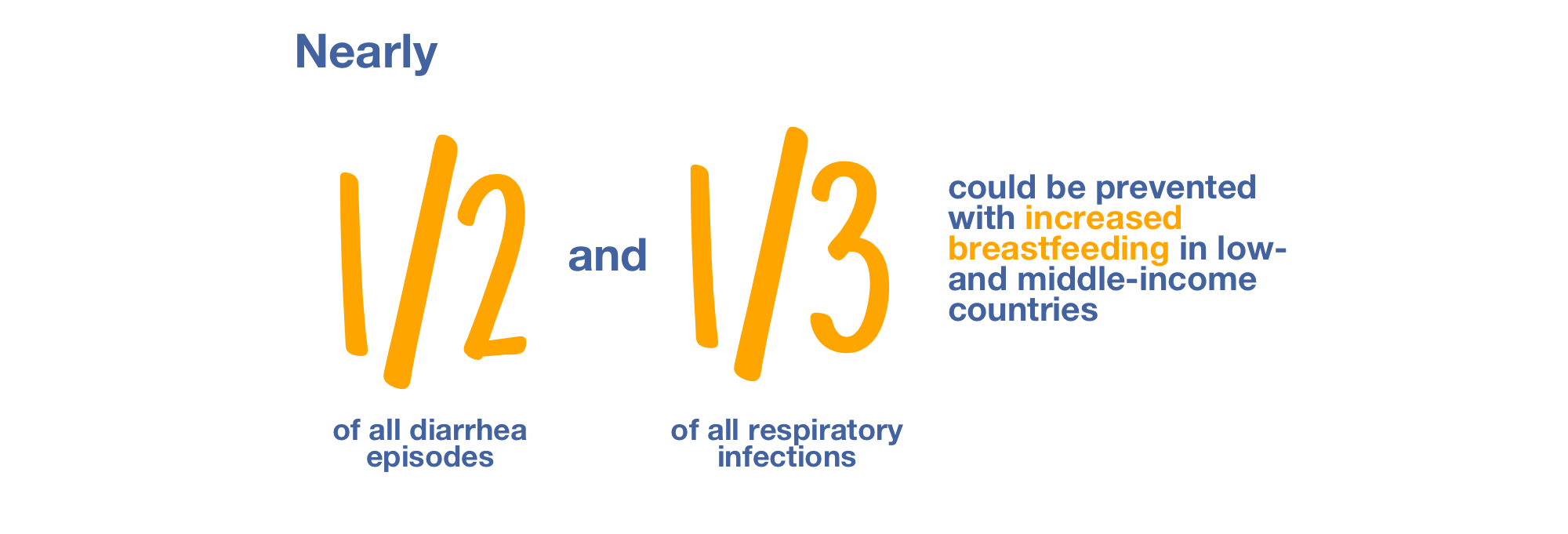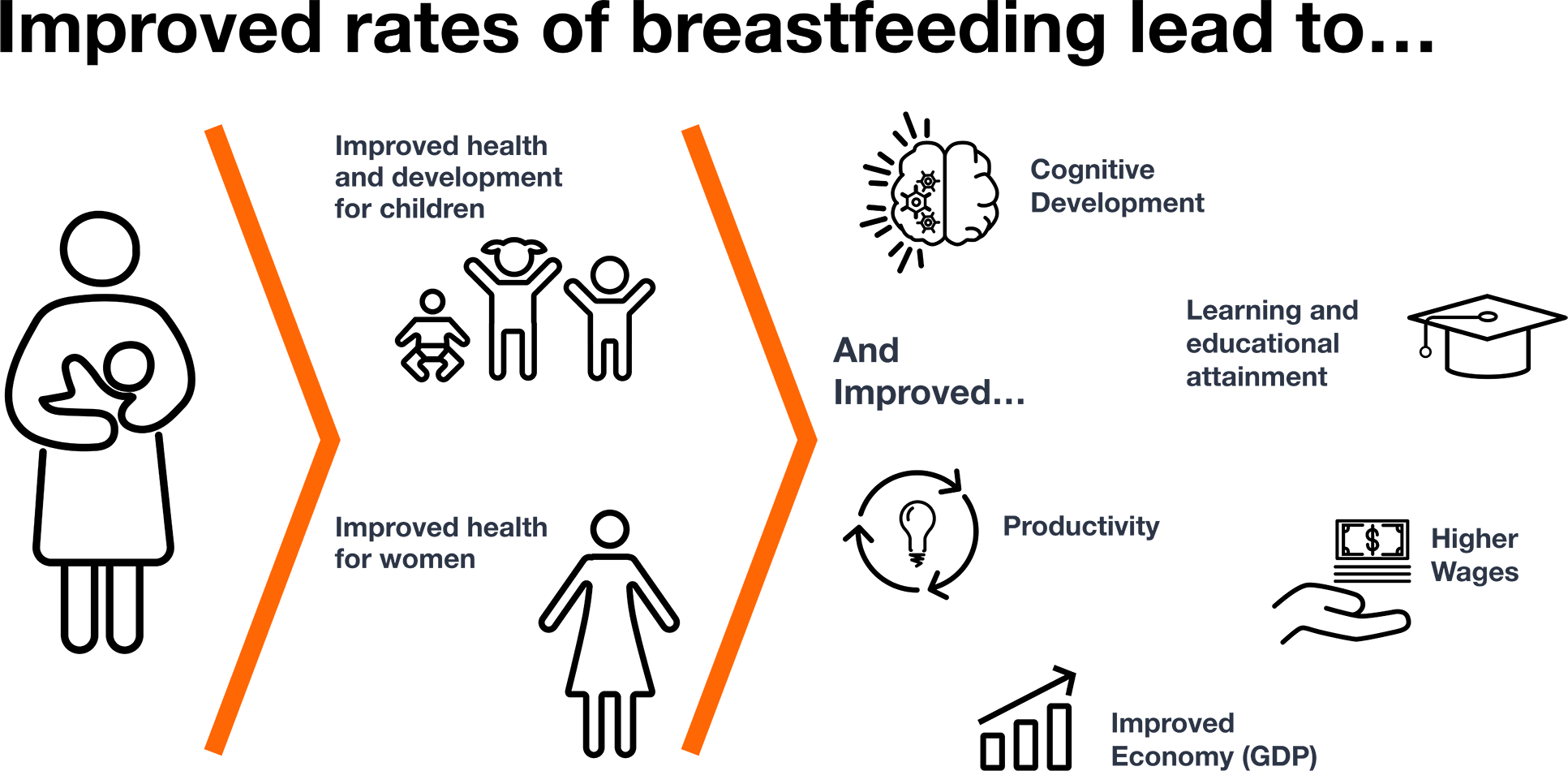Diarrheal Disease Solutions
Breastfeeding & Nutrition
Breastfeeding and good nutrition help ensure that every child can properly develop. Between them, these two critical solutions help protect children from and reduce their exposure to diarrheal disease.
Breastfeeding
Breastfeeding provides all the essential nutrition infants need for growth and development.
– Anthony Lake, Executive Director, UNICEF
found on UNICEF
-
Problem: exposure to diarrhea-causing pathogens, missing breast milk’s anti-infective protections
Infants are at greatest risk of diarrheal disease when they are given foods other than breast milk. This is because they are more likely to be exposed to food- and water-borne pathogens and lose the protection of breast milk’s anti-infective properties.
Still, breastfeeding rates are just under 50% globally. Many women face obstacles breastfeeding due to a lack of knowledge about its benefits and a lack of sufficient support from key family members and communities. Instead, they turn to breast milk substitutes, which can be heavily marketed in areas where these advertisements are unregulated. Substitutes carry risks in areas where water may be unsafe and in areas prone to high levels of infectious disease and the potential for improper food preparation and storage practices. For women who are unable to breastfeed, it’s important that healthy solutions—made with safe water—are available.
Additionally, some mothers don’t produce enough milk or have trouble accessing breast milk. Both issues are critical to ensure a child receives good nutrition.
-
Solution: exclusive and continued breastfeeding
Exclusive breastfeeding has many health benefits for infants, including the prevention and treatment of infections like diarrhea. It provides immediate immune protection to the infant from the mother, stimulates the development of an infant’s immune system, and contains many health- and growth-enhancing properties like enzymes, proteins, and hormones, all of which are unique to breast milk. Breastfeeding also benefits mothers by reducing the risk of breast and ovarian cancer, among other health benefits. Key feeding practices recommended by the World Health Organization (WHO) for infants and young children include:
- Initiating breastfeeding within the first hour of life
- Exclusive breastfeeding for the first six months
- Timely and adequate complementary feeding
- Continued breastfeeding for two years, and
- Good nutrition and restorative feeding for toddlers over age two
Breastfeeding prevents diarrheal disease in two ways:
- It eliminates the risk of a child consuming contaminated food and water at a point in his/her life when his/her digestive system is not fully developed.
- Breast milk contains secretory antibodies and other immune factors that protect against gastrointestinal pathogens. Breast milk has also demonstrated anti-inflammatory and immunomodulatory effects.
For an infant or toddler, continued breastfeeding during and following an episode of diarrhea significantly reduces the risk of dehydration and prevents weight loss and malnutrition. Breastfeeding may also help speed recovery and reduce the severity and duration of an episode.
After six months, when breast milk needs to be complemented with other foods, caregivers should be educated about safe and hygienic food preparation and feeding. Infants and toddlers are particularly vulnerable to malnutrition between six months and two years due to inadequate feeding practices during and after illness.
Successful breastfeeding is a collective, community effort. Mothers need support from families, communities, and their governments.
What are safe alternatives? Donor milk and special cups.
When a mother is unable to breastfeed her child, human milk banks are critical. In 2008, WHO called for member nations to promote the use of donor breast milk from human milk banks for vulnerable babies. To date, there has been progress in human milk banks opening around the world, with the first human milk bank in Asia opening in India in 2016, followed by Vietnam in 2017.Several million babies born each year in Africa and South Asia cannot breastfeed due to prematurity or craniofacial anomalies like cleft lip or palate; however, new inventions like the NIFTY Cup help these babies get the nutrients they need. The cup creates a reservoir and flow channel that allows an infant to lap breastmilk, instead of it being poured down their throats using a traditional cup.
-
Impact: helps prevent and treat infections, saves lives
Breastfeeding could save an estimated 800,000 infants each year by preventing death and stunting from malnutrition. It protects the immune system and promotes physical and cognitive growth and development, in part by preventing infections like pneumonia and diarrhea.
-
Global guidance: breastfeeding
WHO and UNICEF recommend exclusive breastfeeding—where the infant only receives breast milk without additional food or drink—for the first six months of life. This is followed by continued breastfeeding with appropriate complementary foods for up to two years or beyond. Learn more.
The World Health Assembly hopes to achieve at least a 50 percent rate of exclusive breastfeeding during the first six months of life by 2025. Globally, the percent of infants under six months of age exclusively breastfed reached 48% in 2023, close to achieving the target. Learn more.
The Global Breastfeeding Collective (GBC) developed a scorecard to track progress on seven policy actions and on the state of breastfeeding practices within countries. Learn more.
The Maternal and Child Survival Program (MCSP) compiled a list of barriers to exclusive breastfeeding as well as a summary of global guidelines and country actions. Learn more.
By the GBC’s estimates, every dollar invested in increasing breastfeeding generates US$35 in future returns across low- and middle-income countries, resulting in healthier families with higher productivity.
Nutrition
Good health begins with good nutrition. Proper infant and young child nutrition fortifies the immune system against infectious diseases, including diarrhea, and promotes healthy growth and development.
– Dr. Cyril Engmann, Director of Maternal, Newborn and Child Health and Nutrition, PATH
in a DefeatDD Blog
-
Problem: poor nutrition/inability to absorb nutrients
Diarrheal disease and malnutrition are inextricably linked. Diarrhea causes malnutrition, and persistent infections worsen the condition as they leave children’s guts unable to absorb key nutrients. Long-term gut damage caused by repeated enteric infections is called environmental enteric dysfunction (EED).
This condition perpetuates poverty by limiting educational and future economic opportunities.
Just five cases of diarrhea before the age of two can stunt children’s cognitive and physical growth irreversibly. (Source: WaterAid)
Almost 150 million children suffered from wasting in 2020, and the latest data indicate that the COVID-19 pandemic left millions more at risk. According to the 2022 Global Nutrition Report, the world has made some progress in addressing malnutrition. But most countries are not on course to meet their goals for maternal, infant and young child nutrition. Stunting in children less than five years old is also a reflection of many systemic inequalities, both within countries and among them. Country profiles from the 2022 Global Nutrition Report provide further information on these challenges.
-
Solution: proper nutrition
Policy change and funding investments will be essential to reaching nutrition goals that protect the world’s most vulnerable children. In 2021, the Tokyo Nutrition for Growth (N4G) Summit convened national and global stakeholders for an unprecedented level of commitments to maternal, infant and young child nutrition. Progress and challenges will be recorded using the first-ever independent Nutrition Accountability Framework.
-
Global guidance: nutrition
The United Nations Sustainable Development Goal 2 aims to end hunger, achieve food security and improved nutrition, and promote sustainable agriculture. A particular objective targets all forms of malnutrition, including stunting and wasting in children under five years.
Further reading:
- DefeatDD. Diarrheal Disease and Malnutrition Are Inextricably Linked. [3.3MB PDF]
- DefeatDD. Solutions: Nutrition and Breastfeeding.
- Global Nutrition Report.
- The Lancet. Breastfeeding Series.
- UNICEF/WHO. Global Breastfeeding Collective.
- United Nations. Sustainable Development Goal 2.
- World Breastfeeding Week.
- World Health Organization. Breastfeeding.




